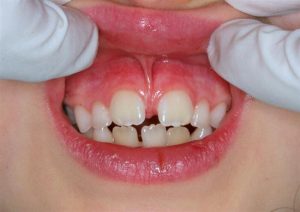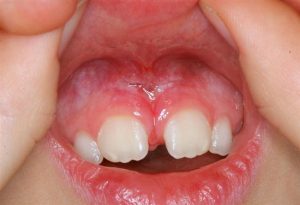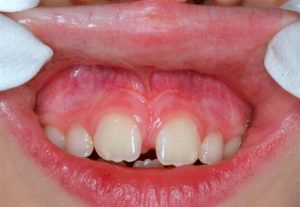PARENT AND PATIENT EDUCATION ON FRENECTOMIES
The tight ligament that attaches the upper lip to the gums is called the labial frenum. The one attaching the tongue to the base of the mouth is the lingual frenum.
The labial frenum should be attached at least 4 mm above the gum crest of the front teeth and should not limit the lip movements. The consequences of a low-attaching frenum are:
- DIASTEMA FORMATION: Due to the fibrous extension of these ligaments extending down in-between the upper front teeth (upper central incisors), spaces between them usually do not close and form what we know as diastemata.
- RECESSION: As the lip moves, it makes the frenum continually tug on the papilla, or the triangular gum tissue filling the space between the upper incisors. In the future, the risk for recession and gum pockets on these teeth is higher.
- OPEN MOUTH POSTURE: The tight ligament limits lip function and prevents it from adapting with the lower lip, or forming a “lip seal”, which is an integral part of healthy nose breathing. Therefore, these children have a higher risk of open mouth posture and mouth breathing, leading to detrimental effects on jaw growth and airway development.
The lingual frenum should also allow for free movement of the tongue, particularly in its role in swallowing, speech, and tooth and jaw development.
A child with a tight lingual frenum is also called “tongue tied”. Consequences are as follows:
- LOW TONGUE POSITION: The tongue lies lower in the mouth, therefore causing abnormal growth of the lower jaw, and insufficient growth of the upper jaw. This causes severe orthodontic problems in the future as well as a tendency for sleep apnea.
- SWALLOWING DYSFUNCTION: Upon swallowing, the tongue should rest against the upper palatal vault. If its frenum is tied, it will rest lower, that is between the teeth. This is called tongue thrust. Orthopedic effects are insufficient growth of the upper jaw, and an open bite if there is an associated tongue thrust.
- LISPING: Due to improper tongue positioning, lisping is a common occurrence.
TREATMENT:
Surgically releasing the frenum is called frenectomy. Conventional treatment involved a procedure where the frenum was cut with a blade or scissors, with or without sutures to reposition its attachment. Today, and in our office, we employ a procedure called “laser frenectomy” in which the Waterlase is used to zap the frenum with laser pulses without even touching it, gently severing it from its attachment.
A few drops of anesthetic makes the area numb enough so even a 6-year old can tolerate it. Healing time is reduced drastically, as the waterlase does not create tissue trauma or charring, as some older lasers did. The actual procedure takes 3-5 minutes, and full healing with new skin is evident within 10 days. The new frenum attachment is at least 5 mm higher up, clearing the gums and releasing the tongue or the lip respectively. Post-operative discomfort is less than what one might think. The area feels sore for 2-3 days, but the child will be able to eat and function normally.
See the video in our video gallery to see Dr. Sarkissian perform a labial frenectomy on a young girl.
For more information, please refer to the Frenectomy Consent and Post-Operative Instructions.



